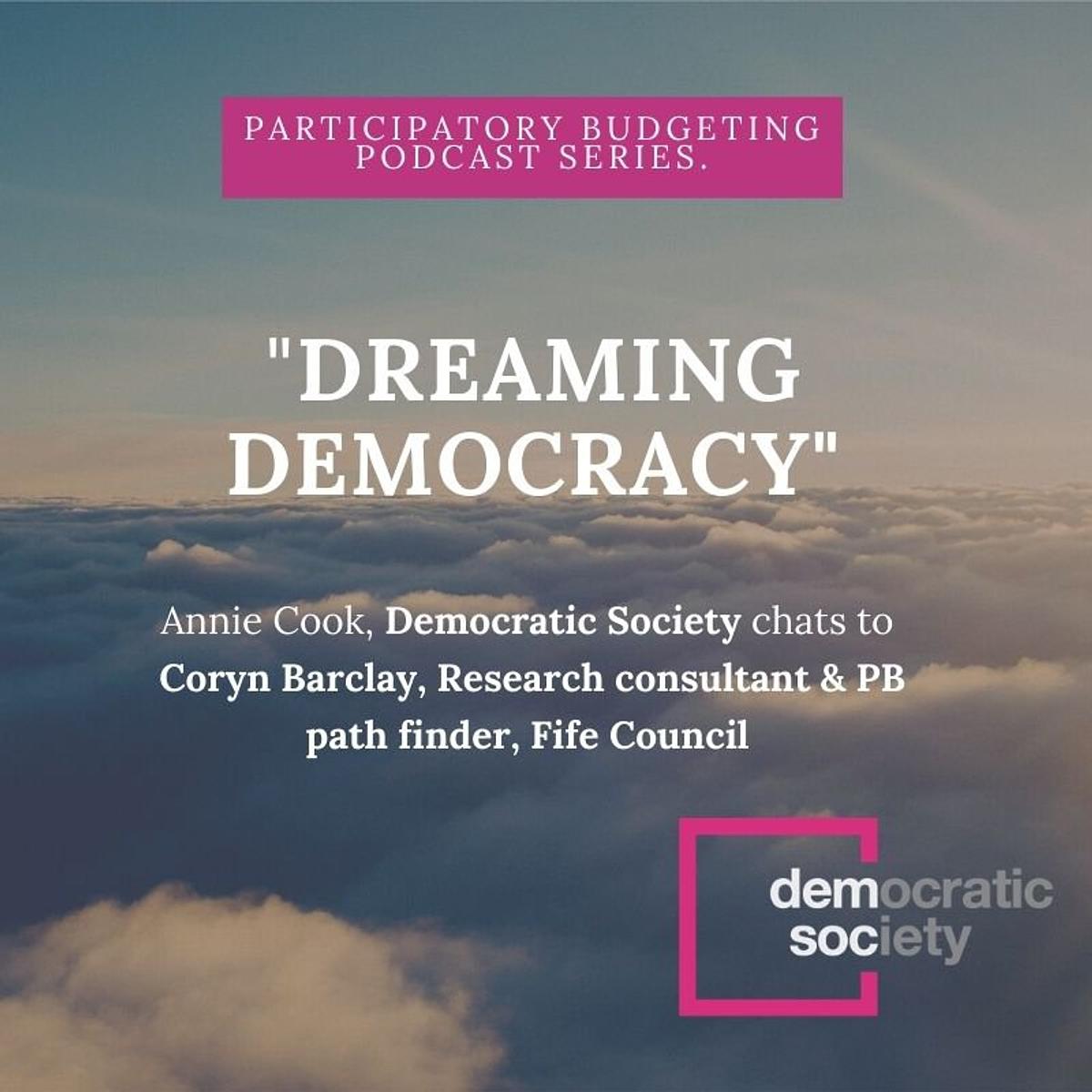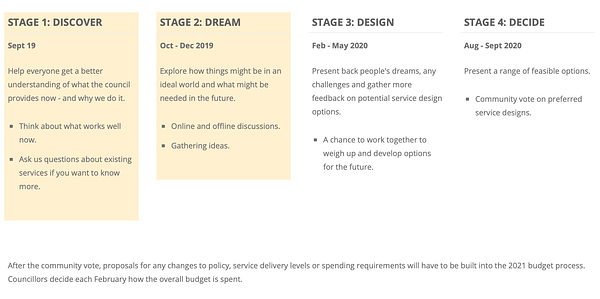
PB in Fife, Scotland
We spoke to Coryn Barclay, Research Consultant and PB Path Finder at Fife Council, about the story of participatory budgeting in Fife, their challenges, and their hopes for the future.
We spoke to Coryn Barclay, Research Consultant and PB Path Finder at Fife Council, about the story of participatory budgeting in Fife, their challenges, and their hopes for the future.
You can listen to the podcast here:
About Fife
Fife is located in eastern Scotland and the local authority area has the third largest resident population in Scotland, with just 373,500 people calling it home - similar to number of people in Iceland. Over a third of residents live in the three principal towns of Dunfermline, Kirkcaldy and Glenrothes.
Fife Council is one of Nesta's 2020 Democracy Pioneers. Coryn is currently writing a Pioneers blog on the Fife PB work, which will be out soon!
Fife’s Participatory Budgeting story
Fife have been using a PB approach since 2010, dispersing around one million pound in small grants to date. There’s now a commitment to spend 1% of the local authority budget through PB as part of the effort to mainstream the approach across Scotland. For Fife, this equates to around 7 million pounds allocated through PB annually - and Coryn says they’re not going to get there through small grants alone.
What have been the biggest challenges since 2010?
“PB is developing organically, some people have adopted it in new areas if they’ve moved and taken it with them as part of their toolkit and spread PB to their communities...It also depends on the political support and committees of elected members- where there has been support for PB there has been more opportunity to do it..PB has taken place in the more deprived areas of Fife which would explain why it’s not been done across all areas of Fife.”
Since September 2019, Fife’s first instance and large scale test of mainstreaming PB has been live: “Let's talk about transporting people”
Fife is a big place covering over 1,325 square kilometers, and the council has allocated 22 million pounds in helping people to use different types of transport to get from A to B. They started a public engagement process last September but it has had to be put on hold at the start of April because of the impact of Covid on the area’s public transport service. However, the council’s reform and recovery planning priorities means subsidised passenger transport is part of their recovery agenda.
What were your original PB plans? Were you planning on doing it online? Idea generation, deliberation? How was it going to work?
“We designed it as a year long public engagement process- testing it out through passenger transport but in theory you could apply that to another area of the councils mainstream budget in the future.”
There are 4 stages with the first two being idea generation stages.

Stage 1: Discover. People could ask the council questions and find out a little bit more and think about what works well now.
Stage 2: Dream. Between September 2019 and January 2020, Fife ran a series of face-to-face engagement sessions, they had postcards delivered through the bus stations and had a debates space on Consul to gather ideas about what might be needed in the future. Have a look at their site “Let’s talk about our Fife” here.
Stage 3: Design. Dream was to move on to a phase called “Keep Dreaming” where they could keep idea generating but moving towards the design and thinking about policy choices. This was to be a deliberative phase, where there would be a Fife’s Citizens’ Jury on passenger transport, bringing people together over the course of a few weekends.
However, Covid has disrupted this original plan and now Fife are in the early stages of planning an online deliberative process and trying to reach the same quality of discussions. They are looking at examples of ways in which this can be done, such as the Citizens’ Assembly for Scotland moving online.
The intentions for the design stage are to convene a representative population of people across Fife who will work through the ideas, have discussions and be enabled to question the people who are delivering the services about how things could be done and what some of the options are. They have also recognised the impact Covid has had on how it has affected people’s use of public transport throughout the pandemic - getting things back up and running and how it all connects to longer-term issues around the climate emergency and the need to do things differently.
“It’s about that balance of what the council should be providing directly or what it should be supporting other agencies to do, and there certainly seems to be a gap around the councils policy on concessions...people need support and it’s not available through other means and it’s an opportunity to explore that through that deliberative space that we’d hope to create through a Citizens Jury.”
Stage 4: Decide. Fife would then hope to take those options to a public vote, ideally using Consul.
Digital Tool: Consul
Fife have been using an installation of Consul since August 2019, with support from Scottish Government and COSLA as part of the national support programme for participatory budgeting.
In Fife, it has partly been about testing out the boundaries of what the platform can and can’t do, how it can work as part of a PB process to complement existing methods to reach people in face to face settings. For example, it doesn't negate the need for a process of stakeholder engagement to understand who has an interest in different aspects of passenger transport, how they will reach them, and what methods they need to do that. However, Consul has certainly helped enhance how they do community engagement and participation generally.
Fife have already used Consul for online voting for small grants through the “Connect East Neuk” process back in August 2019 which aimed to reduce social isolation. This worked really well and has given other people the confidence to think about how they might use Consul as a tool for future PB processes.
They have also been using Consul for the “Let’s talk about transporting people” processes but also to enhance consultation on their Play Spaces Strategy.
“Some people know about it and you will see they come back but it needs to become a mainstream tool in its own sense, currently it is sitting a bit off on the side and I’d quite like to see it more integrated into our system.”
5 top tips in integrating a digital tool like Consul
- Promotion and awareness building.
- Because it [Consul] is sitting on another platform elsewhere, you need to direct people from where they are - for instance, Facebook or other channels.
- Changing people’s expectations about how they interact with the council and creating a co-operative space that is more about dialogue and deliberation and a two-way conversation, rather than contacting the council to complain about something.
- Pose questions positively online and you will get people engaging in a positive way. By doing this, Fife hasn’t had any issues with moderation.
- Thinking about equity of the voting process, you can create other methods to do that in-person such as fill in a form and hand it in, to provide options for people.
Top 3 PB learnings
- If using a digital tool for the first time, keep it simple and don’t try and be too clever with that.
- Think about how online extends or complements your offline engagement processes so it’s not a replacement for it.
- Give it a try, learn from it and improve for the next time. For each of the iterations there are things you can use and adapt. For example, one of the things Fife has learned over time from public voting processes is to have people available from the funding team to follow-up on proposals which weren’t successful.
What would you like to see for Fife in the future?
“Participation becomes the way in which we work...and about how you’re creating opportunities for people to have their say in decisions in their local area. I think I would like to see more of a bottom-up push of that...so how we support that or enable that with communities...and led from communities...I hope people will be open to doing things in a slightly different way.”
Read more about Fife PB story 2010-2017 here.
Further information & international learning
WWS Film - Learning from Paris
WWS Blog - Paris and PB - perceptions, participation and parallels from a Fife perspective
WWS Blog - continuing to learn from international experiences of participatory budgeting
Further Fife related docs on the PB Scotland Khub group including COSLA Fife case study Note: Khub document links are not publicly available and can only be seen by people who are members of the PB in Scotland group.